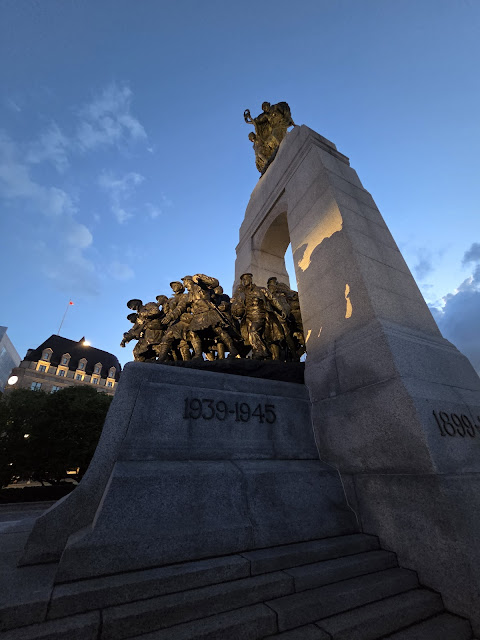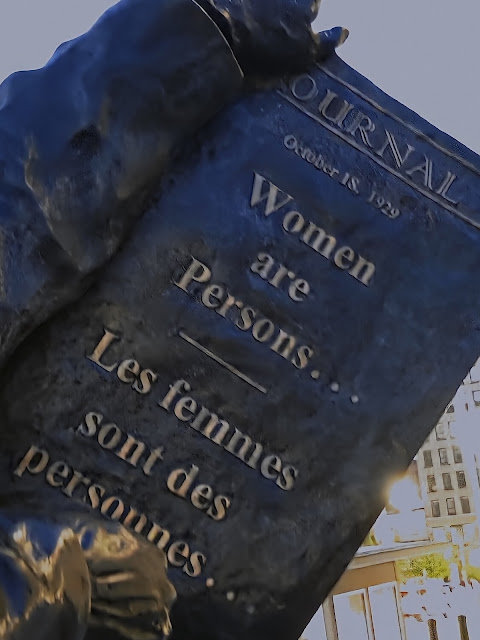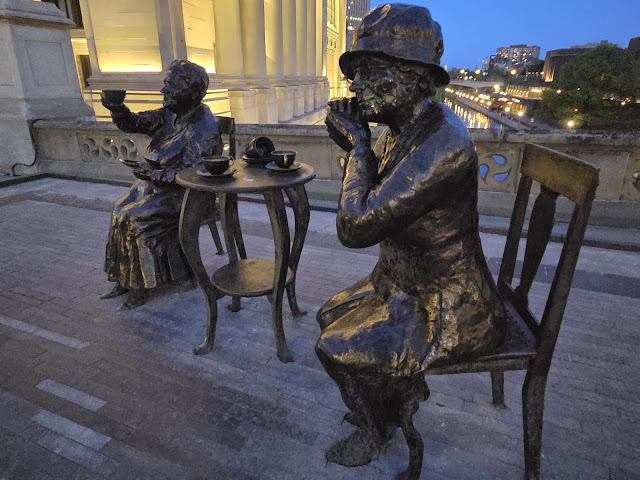Bus 7.5 hrs
Steps 9,000
We've never done a local bus tour but I have always wanted to see the Ottawa Tulip Festival and haven't been in Ottawa for many, many years. It also felt appropriate to do a Canadian trip this year.
My parents would often take us for a drive to Ottawa from Montreal when I was growing up. My lasting memory was the Dunn's strawberry cheesecake we would get on Sparks St.
It is where my high school graduating class went.
We went a couple of times when John was playing ball when we lived in Montreal.
Friends had booked this tour and we thought we'd tag along.
We woke to a horrendous thunderstorm and then our power went out, it was back on quickly and we had quick breakfast before we drove to their house in Burlington and then went to the pick up spot for 8:20. I like the fact that this tour assigns seats on the bus.
These tour guides, husband Vince and wife Laura along with driver Harvey are well organized. There is a water at every seat. Wifi is also available along with charger and plug.
They did a couple of draws for, what else, but Tim Horton cards, gave out Canada pins and a little treat bag.
Both routes take about the same time 5 hours which doesn't include lunch and bio breaks.
We first took the tolled 407 highway that goes around Toronto. The fog rolled back in shortly.
So far we have an annoying Whistler, some smokers who rush off the bus and then return smelly, and a few incessant female yakkers, and someone who's headset leaks static.
We then took the 401 making our first stop was at 10:05 at the Port Hope ONRoute, Ontario's monopoly travel plazas. And the sun came out. Thirty minutes later we're on our way.
Considering the dismal weather forecast we had a gorgeous day.
Highway 401 is 507 km and highway 7 (more scenic) is 464 km.
They ran through the itinerary and made some minor adjustments including leaving an hour earlier on Monday which suited the group.
We then made a lunch stop in Kingston with lots of options for everyone. The four of us went to A&W for burgers and back on the bus for 1:30.
We made an unscheduled stop as the air conditioning wasn't working at the back of the bus.
Then a two hour drive to Ottawa during which they ran a movie, Queen Bees.
Traffic crawled into Ottawa, it's Friday of the first long weekend of summer. Victoria Day or also known as May 2-4.
We were asked to take all our belongings from the bus when we reached Ottawa as a replacement bus would be supplied. HMMM makes me think of Fatima, Portugal a couple of weeks ago.
We are staying at the Lord Elgin Hotel and includes breakfast.
The Lord Elgin Hotel (1941) is a historic gem in Ottawa, offering not just a place to stay but an experience steeped in elegance and charm. Its prime location places guests within walking distance of some of the city's most iconic landmarks and attractions, making it an ideal choice for both leisure and business travelers alike. Locally owned and operated and with a legacy of hospitality spanning over eight decades, it's no wonder that the Lord Elgin continues to be a preferred destination.
We arrived around 4 and Laura had maps and our room keys/breakfast coupons ready and our luggage was delivered to our rooms.
We quickly headed out to wander along Sparks St. Tulips everywhere.
The Lord Stanley's Gift Monument commemorates the donation of the Stanley Cup ice hockey championship trophy by Canada's Governor-General the Lord Stanley of Preston in 1893.
Located across from Parliament Hill, the Wellington Building was constructed in 1927 for the Metropolitan Insurance Company and substantially enlarged in 1959. Acquired by the Crown in 1973, the Building was completely rehabilitated from 2010 to 2016 to accommodate Parliamentary functions.
The Central Post Office was completed in 1939, replacing a Second Empire style office built in 1876. This original office was located in what is today Confederation Square, and was demolished in order to construct the grand public space. The new office was designed by W.E. Noffke, it is located on the western edge of the square at the end of Sparks Street. The new site required the demolition of the Royal Bank of Canada building (built originally for James Hope and Company). The office combines the distinctly Canadian Chateauesque style with Art Deco elements. It is noted for the decorative carved lions arranged around its base.
he "bear on Sparks Street" refers to a bronze sculpture called "Territorial Prerogative" by Bruce Garner. It was originally located at the Elgin Street entrance of the Sparks Street Mall. The sculpture, which depicts a bear consuming a fish, was moved in 2016 to make way for a new monument commemorating the Stanley Cup.
The Bank of Nova Scotia building at 125 Sparks Street was designed in the Beaux-Arts style in 1924 by Belfast architect John MacIntosh Lyle. The symmetrical sandstone south facade includes columns, basins, mahogany and bronze doors, and bas-reliefs inspired by Canadian economic activities. Inside, we note the executive office and the waiting room in walnut and white oak as well as the banking hall, in Doric style, adorned with floors of pink-gray marble from Tennessee, walls in cast stone as well as bronze wall sconces. The bank occupied the building until 1985, after which the building remained vacant for almost 15 years.
Renovations began in April 2000 and the Library of Parliament moved in in July 2001. Modern features added to the building include a new north facade entirely covered in glass on the exterior. Inside, a mezzanine is added to connect maple and steel offices to five stories of shelving with glass floors.
In 2017 the branch was redesigned as the Interim Main Library. Modernizing the building has helped the Library of Parliament meet the ever-changing needs of its parliamentary users. The space now includes a new reading room equipped with a multimedia wall on which news and sittings of the two houses of Parliament are broadcast, three collaborative rooms and an event hosting capacity.
In 1983, the Regional Municipality of Ottawa-Carleton commissioned artist John Hooper to create a bronze sculpture of the legendary Terry Fox. Since 1998.
The Terry Fox Memorial Sculpture and accompanying plaque have found a new home on Sparks Street, east of the entrance to 197 Sparks Street. The new location for the sculpture is fitting; it falls along the original route that Terry Fox took during his Marathon of Hope in 1980.
Parliament Hill (French: Colline du Parlement), colloquially known as The Hill, is an area of Crown land on the southern bank of the Ottawa River that houses the Parliament of Canada. It accommodates a suite of Gothic revival buildings whose architectural elements were chosen to evoke the history of parliamentary democracy. Parliament Hill attracts approximately three million visitors each year. The Parliamentary Protective Service is responsible for law enforcement on Parliament Hill and in the parliamentary precinct, while the National Capital Commission is responsible for maintaining the nine-hectare (22-acre) area of the grounds.
Development of the area, which in the 18th and early 19th centuries[citation needed] was the site of a military base, into a governmental precinct began in 1859 after Queen Victoria chose Ottawa as the capital of the Province of Canada. Following several extensions to the Parliament and departmental buildings, and a fire in 1916 that destroyed the Centre Block, Parliament Hill took on its present form with the completion of the Peace Tower in 1927. In 1976, the Parliament Buildings and the grounds of Parliament Hill were designated as National Historic Sites of Canada. Since 2002, an extensive $3 billion renovation-and-rehabilitation project has been underway throughout the precinct's buildings that is expected to be completed after 2028.
The National Press Building just across from the West Block of the Parliament Buildings, that houses the Parliamentary Press Gallery. The building is owned by the federal government. Originally the press had their offices inside the Centre Block of the Parliament buildings. By the mid-1960s these areas had become overcrowded, and the large number of journalists based in desks lined against the walls of hallways were deemed a fire hazard. Thus the press were moved to their new home across the street. The Italian Renaissance building, originally named the Norlite Building, had been constructed in 1917-1919 and originally held several government agencies.
Offices in the building are provided to journalists at cost by the federal government, with some other facilities remaining in the Centre Block. The building is home to a wide array of news agencies, both national and foreign, and all forms of media. The building is often described as "dingy" and the offices are very small, and many larger organizations thus choose to base their reporters elsewhere. In 2004, the CBC moved its parliamentary bureau from the building to the new CBC Ottawa Broadcast Centre. The National Press Club is situated on the second floor.
The Bank of Montreal's (Canada's oldest chartered bank) original building in Ottawa is now known as the Sir John A. Macdonald Building. It's located at 144 Wellington Street, opposite Parliament Hill. This landmark building was constructed between 1929 and 1932 and features a blend of classical and Modern Classical architectural styles.
John remembers when he worked in Ottawa for BMO he would have to go to this branch to get cash ($50,000) he would go through the back door on Sparks St. and then be escorted back to his branch by the police.
The Bank of Montreal vacated the building in 2005, and it was later renamed the Sir John A. Macdonald Building in 2012 to honor Canada's first prime minister.
The building is now owned by the federal government and serves as a space for Parliamentary events and meetings.
Side of BMO.
The CIBC building on the north side of Sparks Street in Ottawa is the original building for the Canadian Bank of Commerce in the city, having been the bank's main branch since 1922. The building is a Beaux-Arts design, recognized as a Federal Heritage Building. The bank established its presence in Ottawa in 1874 and was particularly involved in the development of the timber and lumber trades.
The building was opened in 1981 with the Royal Bank of Canada as its main occupant and accordingly it was named the Royal Bank Centre. As with many Ottawa office buildings it also became home to a number of federal government offices. In March 2001, the building was purchased by the federal government for 66 million dollars. The next year, it was renamed after Father of Confederation Thomas D'Arcy McGee, who was assassinated in 1868 near the site of the building. It is still RBC's Ottawa headquarters and the bank's logo remains on the structure.
The site was once occupied by a row of stores including hat maker and retailer R.J. Devlin Limited, which later operated as Morgan's (which became the Hudson Bay Company).
I booked a reservation for 7 at Johnny Farina's for pizza/pasta. It is just a five minute walk from the hotel.
The restaurant looks inviting. The wine was good. But the four of us agreed that the food was mediocre. One sent his meal back as burnt. Another said her pasta was lukewarm. The GF pizza crust was a little burnt and doughy. My veal just looked a mess and the veal lacked any flavour.
Service was rushed and unimpressive.
We went for a walk after.
National Arts Centre
Central Chambers is a building that is a National Historic Site. It faces the Canadian War Memorial at Confederation Square. Central Chambers was built between 1890 and 1893[1] and designed by John James Browne of Montreal, an example of Queen Anne Revival commercial architecture. Formerly serving as an office for the Canadian Atlantic Railway, it now houses the National Capital Commission.
The National War Memorial (French: Monument commémoratif de guerre du Canada), titled The Response (French: La Réponse), is a tall, granite memorial arch with accreted bronze sculptures in Ottawa, Ontario, designed by Vernon March and first dedicated by King George VI in 1939. Originally built to commemorate the Canadians who died in the First World War, it was in 1982 rededicated to also include those killed in the Second World War and Korean War and again in 2014 to add the dead from the Second Boer War and War in Afghanistan, as well as all Canadians killed in all conflicts past and future. It now serves as the pre-eminent war memorial[1] of 76 cenotaphs in Canada.[2] In 2000, the Tomb of the Unknown Soldier was added in front of the memorial and symbolizes the sacrifices made by all Canadians who have died or may yet die for their country.
With the 25th anniversary of the Tomb of the Unknown Soldier and the commemorative ceremony taking place on May 28, 2025, I wanted to take this moment to share an excerpt from Legion Magazine’s coverage of the original ceremony. It conveys the importance and the symbolism that the Tomb of the Unknown Solider carries.
The Tomb of the Unknown Soldier
Dan Black
September 1, 2000
“He gave everything, including his name. He died on a muddy battlefield in France more than 80 years ago and because of that we know very little about him. He is Canada’s Unknown Soldier and the nation welcomed him home with tremendous dignity last May and laid him to rest in a tomb in front of the National War Memorial. It is a powerful story, but it does not end with the funeral; it endures so long as we–and generations to come–remember his symbolic sacrifice and pause long enough every day to think about the hope and the fear associated with preserving the kind of peace and freedom he fought and died for.
‘He Is A Symbol Of All Sacrifice’”
Another shot of the Arts Centre.
Rideau Canal.
Union Station was built to serve as Ottawa's central railway station. It was constructed on the site of the old Central Railway Depot, built in 1896 by the Canada Atlantic Railway established some eighteen years earlier by Canadian lumber baron John R. Booth.
Ottawa's Union Station (now the Senate of Canada Building) is linked to the Titanic tragedy because it opened on June 1, 1912, six weeks after Charles Hays, the Grand Trunk Railway's general manager, died in the disaster. Hays had played a key role in developing Ottawa's railway infrastructure, including the construction of Union Station. The station opened without ceremony in deference to Hays's passing.
Construction of the new station began in July 1909. After multiple delays the station finally opened to the public in June 1912.
The threat to the Union Station building began in the late 1940s when “The Greber Plan" recommended removal of the railways from central Ottawa in favour of a scenic driveway. To this end, the National Capital Commission (NCC) entered into an agreement with the railway companies on December 1, 1959 to construct a new railway station southeast of the core in the Hurdman’s Bridge area, in exchange for Union Station.
Union Station ceased operations as a passenger train facility in 1966. When intentions to demolish Union Station became apparent — to create parking for visitors during the 1967 centennial — voices rose in objection.
The Château Laurier Hotel, constructed during the same time frame and located across the street, opened on the same day. The Hotel and Station were connected by a tunnel.
Prior to 1929, Canada’s constitution said that only “qualified persons”—meaning men only—could be appointed to the Senate. It was in that year that five courageous and idealistic Canadian women stepped onto the world stage to challenge these antiquated laws and conventions. By insisting that women be officially recognized as persons in the fullest legal sense of the word the “Famous Five”, as they became known, set a stirring example of leadership that altered all Commonwealth nations’ laws and, with it, the course of history.
The "Women Are Persons!" monument, commemorating the Famous Five, is located in both Ottawa (on the Plaza Bridge near the Senate of Canada) and Calgary (in Olympic Plaza). This sculpture honors Irene Parlby, Louise McKinney, Nellie McClung, Emily Murphy, and Henrietta Muir Edwards, who fought for women's rights in Canada. The monument's design was created by Barbara Paterson and features the five women depicted as they might have heard the news of their victory in the "Persons" case, which legally recognized women as "persons" under the law.
It seems this resembles a tulip lying down. It is the Ottawa Congress Centre.
Our hotel, The Lord Elgin.
Across the street in Confederation Park.
Tthe National Aboriginal Veterans Monument, the Animals in War Memorial










































































...I have enjoyed many of these sites.
ReplyDeleteYes, Tom, I remember reading about your trip and meeting up with William.
DeleteSo much gorgeous architecture and YAY for assigned bus seats! Boooo to the smokers and yappers and other irritants. lol
ReplyDeleteI know I would enjoyed all the sites and as well as the cheese cake.
ReplyDelete